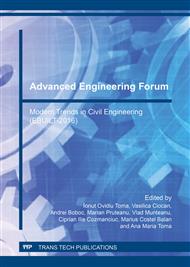[1]
C. M. O. Macinnis-Ng, M. J. B. Zeppel, A. R. Palmer, and D. Eamus, Seasonal variations in tree water use and physiology correlate with soil salinity and soil water content in remnant woodlands on saline soils, J. Arid Environ., vol. 129, p.102–110, Jun. (2016).
DOI: 10.1016/j.jaridenv.2016.02.011
Google Scholar
[2]
G. Aubert, les sols sodiques en afrique du nord, in Annale Agronomique de l'Institut National. Alger, Algérie, vol. VI, 1975, p.185–196.
Google Scholar
[3]
K. Moussa, Etude d'une Sebkha ; la Sebkha d'Oran (Ouest algérien), Géologie, Oran, Algérie., USTO, (2007).
Google Scholar
[4]
M. Chikhaoui, A. Nechnech, D. Hoxha, and K. Moussa, Contribution to the Behavior Study and Collapse Risk of Underground Cavities in Highly Saline Geological Formations, in Engineering Geology for Society and Territory - Volume 6, G. Lollino, D. Giordan, K. Thuro, C. Carranza-Torres, F. Wu, P. Marinos, and C. Delgado, Eds. Cham: Springer International Publishing, 2015, p.393.
DOI: 10.1007/978-3-319-09060-3_68
Google Scholar
[5]
J. E. Low, F. A. Loveridge, W. Powrie, and D. Nicholson, A comparison of laboratory and in situ methods to determine soil thermal conductivity for energy foundations and other ground heat exchanger applications, Acta Geotech., vol. 10, no. 2, p.209–218, Apr. (2015).
DOI: 10.1007/s11440-014-0333-0
Google Scholar
[6]
M. Rezaei, P. Seuntjens, R. Shahidi, I. Joris, W. Boënne, B. Al-Barri, and W. Cornelis, The relevance of in-situ and laboratory characterization of sandy soil hydraulic properties for soil water simulations, J. Hydrol., vol. 534, p.251–265, Mar. (2016).
DOI: 10.1016/j.jhydrol.2015.12.062
Google Scholar
[7]
B. P. Mohanty, R. S. Kanwar, and C. J. Everts, Comparison of Saturated Hydraulic Conductivity Measurement Methods for a Glacial-Till Soil, Soil Sci. Soc. Am. J., vol. 58, no. 3, p.672, (1994).
DOI: 10.2136/sssaj1994.03615995005800030006x
Google Scholar
[8]
D. Mallants, D. Jacques, P. -H. Tseng, M. T. van Genuchten, and J. Feyen, Comparison of three hydraulic property measurement methods, J. Hydrol., vol. 199, no. 3–4, p.295–318, Dec. (1997).
DOI: 10.1016/s0022-1694(96)03331-8
Google Scholar
[9]
J. Mertens, H. Madsen, M. Kristensen, D. Jacques, and J. Feyen, Sensitivity of soil parameters in unsaturated zone modelling and the relation between effective, laboratory and in-situ estimates, Hydrol. Process, vol. 19, no. 8, p.1611–1633, May (2005).
DOI: 10.1002/hyp.5591
Google Scholar
[10]
A. H. Hammam and M. Eliwa, Comparison between results of dynamic & static moduli of soil determined by different methods, HBRC J., vol. 9, no. 2, p.144–149, Aug. (2013).
DOI: 10.1016/j.hbrcj.2013.05.002
Google Scholar
[11]
J. A. Schneider, L. Hoyos, P. W. Mayne, E. J. Macari, and G. J. Rix, Field and laboratory measurements of dynamic shear modulus of Piedmont residual soils, in Geotechnical Special Publication, Charlotte, NC, USA, 1999, vol. 92, p.12–25.
Google Scholar
[12]
F. Homand, A. Giraud, S. Escoffier, A. Koriche, and D. Hoxha, "Permeability determination of a deep argillite in saturated and partially saturated conditions, Int. J. Heat Mass Transf., vol. 47, no. 14–16, p.3517–3531, Jul. (2004).
DOI: 10.1016/j.ijheatmasstransfer.2004.02.012
Google Scholar
[13]
LTPO, Reconnaissance géotechnique préliminaire de la 2ème Piste (07/25) de l'Aerodrome d'Oran Es-Sénia. (2005).
Google Scholar
[14]
LTPO, Contrôle et suivi géotechnique des traveaux de réalisation de la 2ème Piste (07/25) de l'Aerodrome d'Oran Es-Sénia. LTPO, (2007).
Google Scholar
[15]
NF P94-093, Sols : reconnaissance et essais - Détermination des références de compactage d'un matériau - Essai Proctor normal. Essai Proctor modifié. Afnor, (1999).
Google Scholar
[16]
NF P 94-074, 1994, Sols : Reconnaissance et essais. Essais à l'appareil triaxial de révolution. Normes Française. Afnor. (1994).
Google Scholar
[17]
J. -M. Fleureau, J. -C. Verbrugge, P. J. Huergo, A. G. Correia, and S. Kheirbek-Saoud, Aspects of the behaviour of compacted clayey soils on drying and wetting paths, Can. Geotech. J., vol. 39, no. 6, p.1341–1357, Dec. (2002).
DOI: 10.1139/t02-100
Google Scholar
[18]
J. Biarez and P. Y. Hischer., Lois de comportement des sols remaniés et des matériaux granulaires, 3ème edition. Ecole centrale de Paris., (1990).
Google Scholar
[19]
P 94-512-11, ICS, Détermination de perméabilité à charge constante et à charge variable décroissante. Reconnaissance et essais géotechniques. Essais de laboratoire sur les sols. Indice de classement : 13. 080. 20 ; 93. 020. Normes AFNOR 2005. ISSN 0335-3931.
Google Scholar
[20]
J. P. Baud and M. Gambien, Obtaining the Ménard α Rheological Factor in a Pressiorama® Diagram, in 18th ICSMGE, Paris, France, 2013, vol. 1, p.487–490.
Google Scholar


